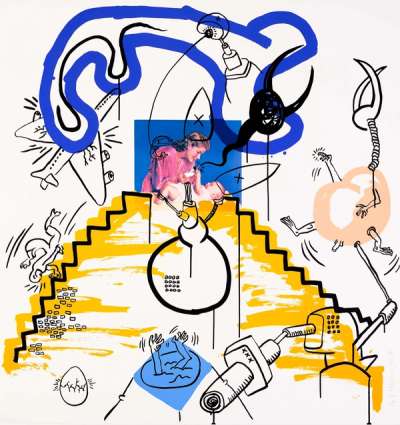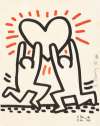Apocalypse
Keith Haring collaborated with William S. Burroughs to create the 1988 Apocalypse series, a series of 10 screen-prints. Inspired by Burroughs' broken-down language early on, Haring injected his art with its pictographic language. The imagery portrays scenes of violence, war and destruction, living up to its hellish title.
Keith Haring Apocalypse For sale
Apocalypse Value (5 Years)
Works from the Apocalypse series by Keith Haring have a strong market value presence, with 149 auction appearances. Top performing works have achieved standout auction results, with peak hammer prices of £91515. Over the past 12 months, average values across the series have ranged from £4546 to £11000. The series shows an average annual growth rate of 8.1%.
Apocalypse Market value
Auction Results
| Artwork | Auction Date | Auction House | Return to Seller | Hammer Price | Buyer Paid |
|---|---|---|---|---|---|
 Apocalypse 5 Keith Haring Signed Print | 10 Dec 2025 | Forum Auctions London | £9,350 | £11,000 | £14,000 |
 Apocalypse 2 Keith Haring Signed Print | 10 Dec 2025 | Forum Auctions London | £5,950 | £7,000 | £9,000 |
 Apocalypse 7 Keith Haring Signed Print | 10 Dec 2025 | Forum Auctions London | £6,375 | £7,500 | £9,500 |
 Apocalypse 8 Keith Haring Signed Print | 10 Dec 2025 | Forum Auctions London | £5,950 | £7,000 | £9,000 |
 Apocalypse 10 Keith Haring Signed Print | 10 Dec 2025 | Forum Auctions London | £6,375 | £7,500 | £9,500 |
 Apocalypse 6 Keith Haring Signed Print | 10 Dec 2025 | Forum Auctions London | £5,950 | £7,000 | £9,000 |
 Apocalypse 9 Keith Haring Signed Print | 16 Apr 2025 | Phillips New York | £3,868 | £4,550 | £6,000 |
 Apocalypse 4 Keith Haring Signed Print | 5 Dec 2024 | Karl & Faber | £4,038 | £4,750 | £6,500 |
Sell Your Art
with Us
with Us
Join Our Network of Collectors. Buy, Sell and Track Demand
Meaning & Analysis
One of Harings more enigmatic prints, the Apocalypse series shows him use his signature graffiti-style, bold mark-making on found images. The set of 10 screen prints juxtapose borrowed images with Haring’s graffiti-inspired bold and curving lines, elegantly linked together with blocks of primary colour.
Published in 1988, the series was born from a collaboration with the Beat Era poet and novelist William S. Burroughs, whose text-based ‘cut-up’ method formed the basis of Haring’s pictographic style. Whilst a student at the School of Visual Arts, Haring came across the Beat poets at the 1978 Nova Convention and had been inspired by Burroughs’ methods of breaking down language ever since. As with much of his other works, Haring adopts a system of expression inspired by Egyptian hieroglyphics in this series, that repeats and appropriates a set of motifs to create a memorable pictorial language. Read in conjunction with Burroughs’ free-form text, Haring’s prints represent disjointed, violent and at times perplexing episodes that imagine the horrors of Armageddon.
Reflecting a shift from Haring’s more light-hearted early works, the Apocalypse series is dark and menacing, made during the final years of his life when he was living with AIDS. The series is characterised by scenes of war, destruction, and visions of hell on earth. Among drawings of grotesque beasts, satanic symbols, serpents, crumbling cities, TVs and technological-age hybrid monsters, Haring embeds collaged images of high art, Christ icons and 1950s magazine clippings of children. The collage components, juxtaposed with the artist’s raw gestural marks, produces a jarring effect that emphasises the otherworldliness of his subjects.


















